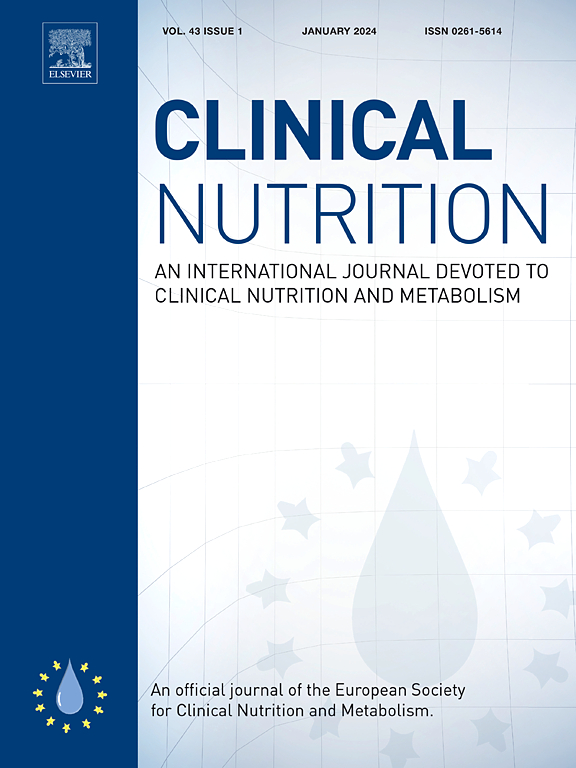Omega-3多不饱和脂肪酸与成人非酒精性脂肪性肝病:随机对照试验的荟萃分析
IF 6.6
2区 医学
Q1 NUTRITION & DIETETICS
引用次数: 0
摘要
背景和目的非酒精性脂肪性肝病(NAFLD)是世界范围内肝脏疾病的主要原因。先前的荟萃分析调查了ω-3多不饱和脂肪酸(ω-3 PUFA)对NAFLD的影响,报告了不一致的结果。本研究旨在评价ω-3 PUFA治疗成人NAFLD的疗效和不良反应(ae)。方法检索spubmed、MEDLINE、Embase和Cochrane Library数据库,检索截至2024年11月30日发表的随机对照试验(rct)。数据汇总,采用随机效应模型进行meta分析。使用Cochrane协作的风险偏倚2.0工具。根据治疗时间、剂量、代谢功能障碍相关脂肪性肝病(MASLD)、非酒精性脂肪性肝炎(NASH)、年龄和性别对天冬氨酸转氨酶(AST)和丙氨酸转氨酶(ALT)水平进行亚组分析。结果共纳入20项随机对照试验,共1615名受试者。总体偏倚风险为5/20低风险(25%),4/20高风险(20%)和11/20某些问题(55%)。ω-3 PUFA补充剂与对照组相比,显著改善了γ -谷氨酰转移酶(GGT) (WMD = - 5.38 IU/L, 95% CI: - 9.16至- 1.61)和肝脂肪变性超声检查(US) (OR = 3.83, 95% CI: 1.03至14.27),但存在发表偏倚。通过磁共振波谱(MRS)或磁共振质子密度脂肪分数(MRI-PDFF)、肝脏硬度或组织学测量,未观察到对AST、ALT或肝脏脂肪的显著影响。ω-3 PUFA组与对照组相比,更有可能经历总体ae。然而,报告充分信息的随机对照试验数量有限。结论ω-3 PUFA可改善GGT水平和肝脂肪变性。然而,大量的异质性和有限的基于超声的研究需要进一步精心设计的随机对照试验。此外,在补充期间仔细监测不良反应是必要的,强调需要长期的安全性数据。本文章由计算机程序翻译,如有差异,请以英文原文为准。
Omega-3 polyunsaturated fatty acids and nonalcoholic fatty liver disease in adults: A meta-analysis of randomized controlled trials
Background and aims
Nonalcoholic fatty liver disease (NAFLD) is the leading cause of liver disease worldwide. Previous meta-analyses investigating the effects of omega-3 polyunsaturated fatty acids (ω-3 PUFA) on NAFLD have reported inconsistent findings. This study aimed to evaluate the efficacy and adverse (AEs) of ω-3 PUFA in adults with NAFLD.
Methods
PubMed, MEDLINE, Embase, and Cochrane Library databases were searched for randomized controlled trials (RCTs) published until November 30, 2024. Data were pooled, and meta-analyses were conducted using a random-effects model. The Cochrane Collaboration's Risk of Bias 2.0 tool was used. Subgroup analyses of aspartate aminotransferase (AST) and alanine transaminase (ALT) levels were performed based on treatment duration, dosage, metabolic dysfunction-associated steatotic liver disease (MASLD), nonalcoholic steatohepatitis (NASH), age, and sex.
Results
Twenty RCTs with 1615 participants were included. The overall risk of bias was 5/20 low risk (25 %), 4/20 high risk (20 %) and 11/20 some concerns (55 %). ω-3 PUFA supplementation significantly improved gamma-glutamyltransferase (GGT) (WMD = −5.38 IU/L, 95 % CI: −9.16 to −1.61) and hepatic steatosis assessed by ultrasonography (US) (OR = 3.83, 95 % CI: 1.03 to 14.27) compared with the control group, although publication bias was observed. No significant effects were observed on AST, ALT, or hepatic fat measured by magnetic resonance spectroscopy (MRS) or MRI-proton density fat fraction (MRI-PDFF), hepatic stiffness, or histology. ω-3 PUFA group was more likely to experience overall AEs compared with the control group. However, the number of RCTs reporting sufficient information was limited.
Conclusions
ω-3 PUFA supplementation may improve GGT levels and hepatic steatosis assessed by US. However, substantial heterogeneity and the limited number of ultrasound-based studies necessitate further well-designed RCTs. Moreover, careful monitoring of AEs during supplementation was necessary, highlighting the need for long-term safety data.
求助全文
通过发布文献求助,成功后即可免费获取论文全文。
去求助
来源期刊

Clinical nutrition
医学-营养学
CiteScore
14.10
自引率
6.30%
发文量
356
审稿时长
28 days
期刊介绍:
Clinical Nutrition, the official journal of ESPEN, The European Society for Clinical Nutrition and Metabolism, is an international journal providing essential scientific information on nutritional and metabolic care and the relationship between nutrition and disease both in the setting of basic science and clinical practice. Published bi-monthly, each issue combines original articles and reviews providing an invaluable reference for any specialist concerned with these fields.
 求助内容:
求助内容: 应助结果提醒方式:
应助结果提醒方式:


